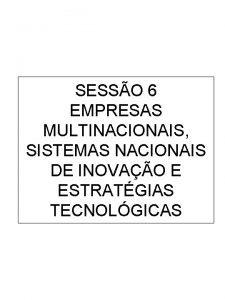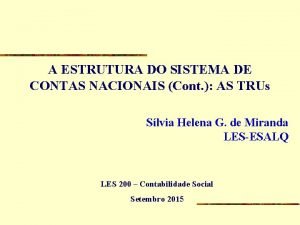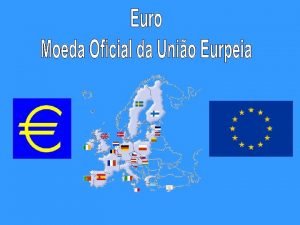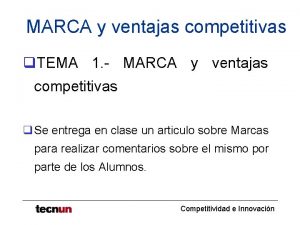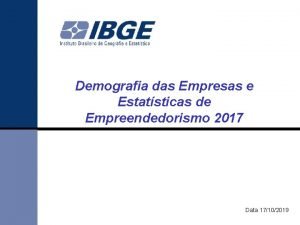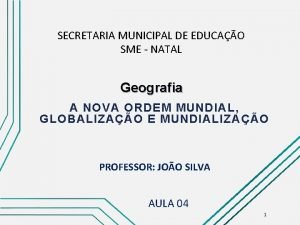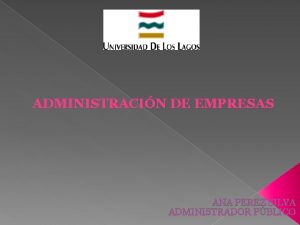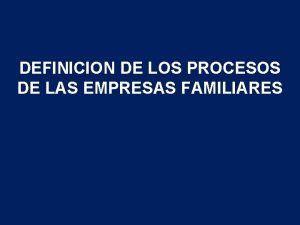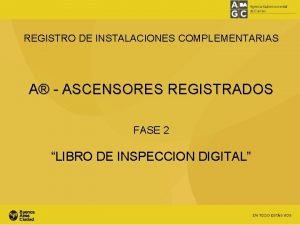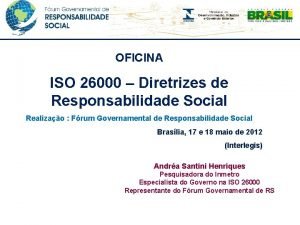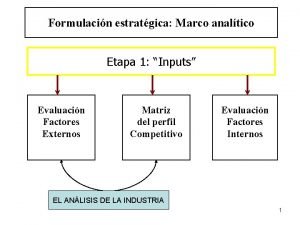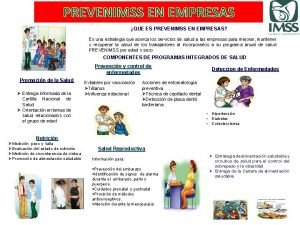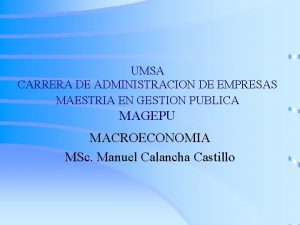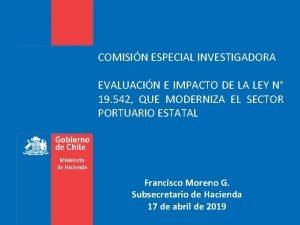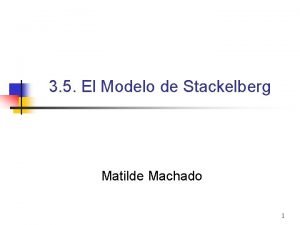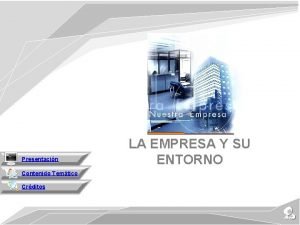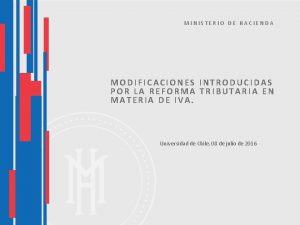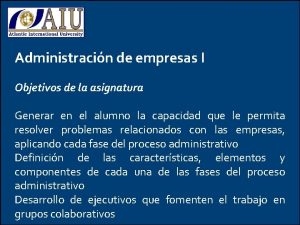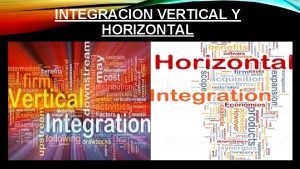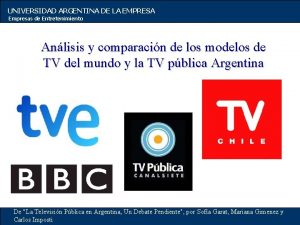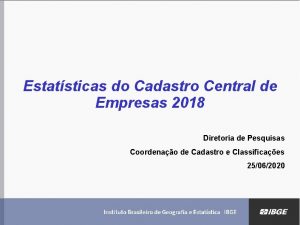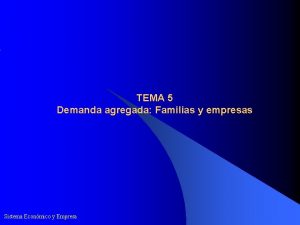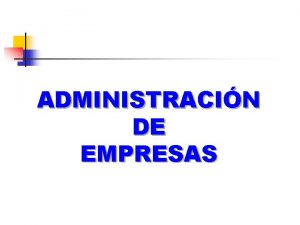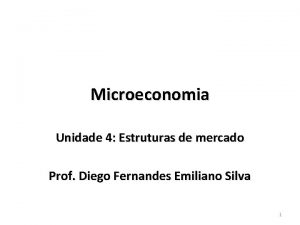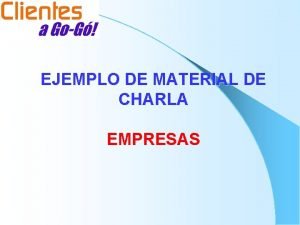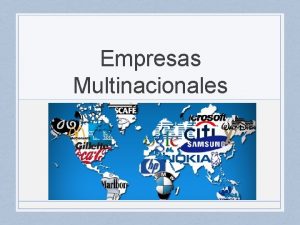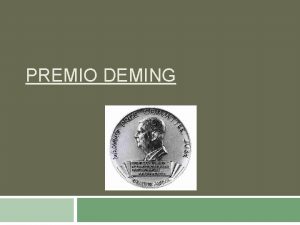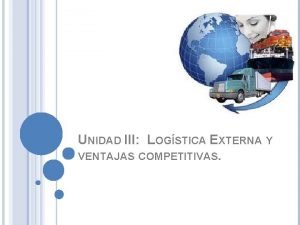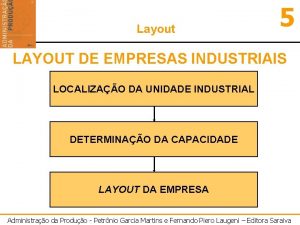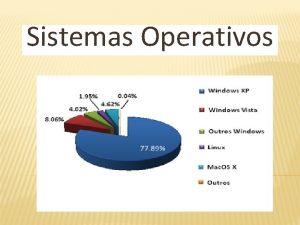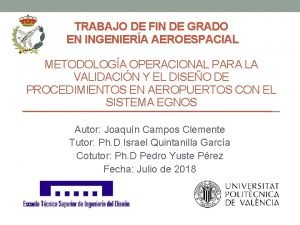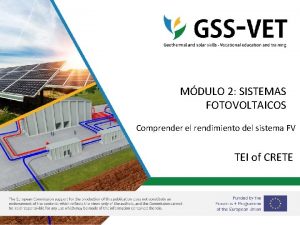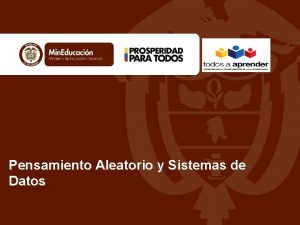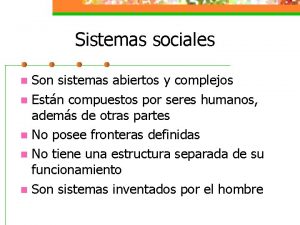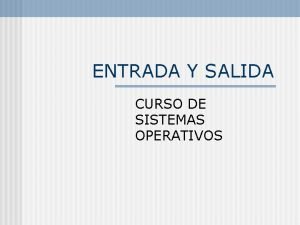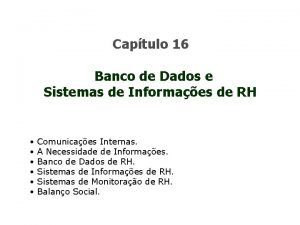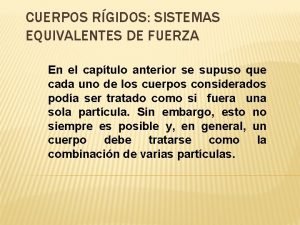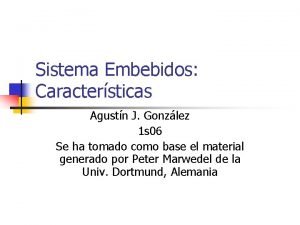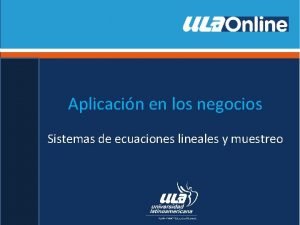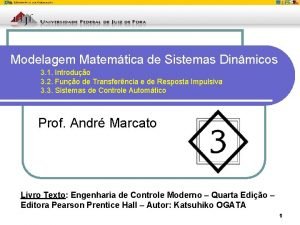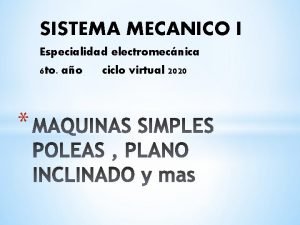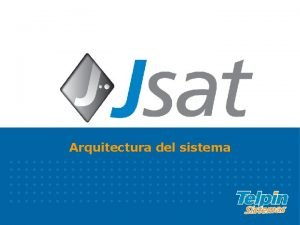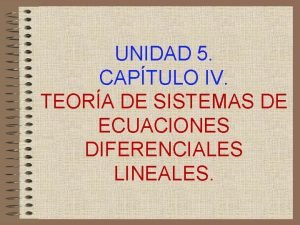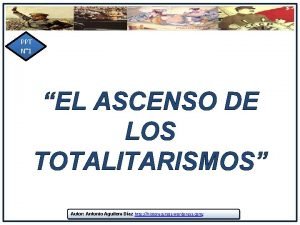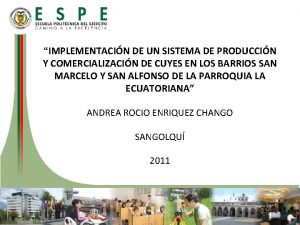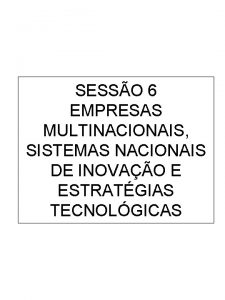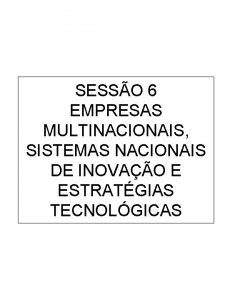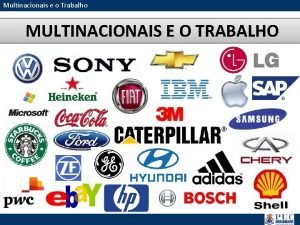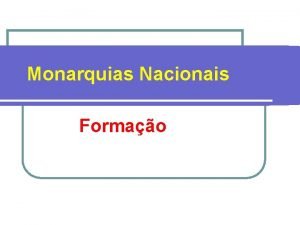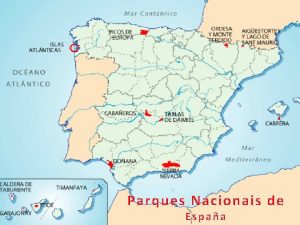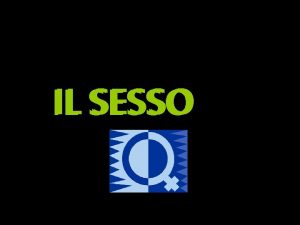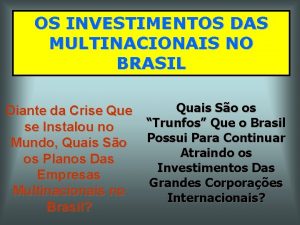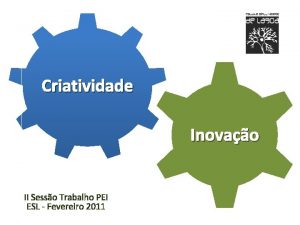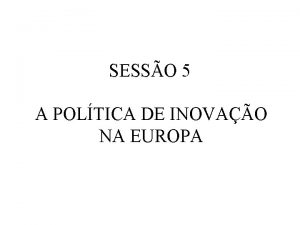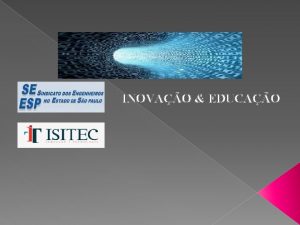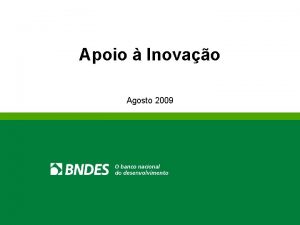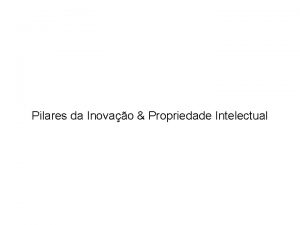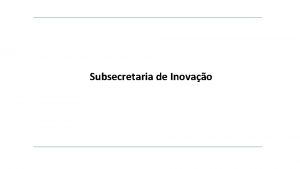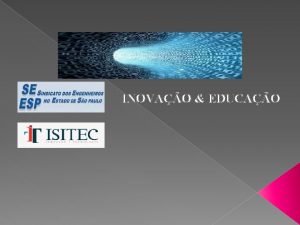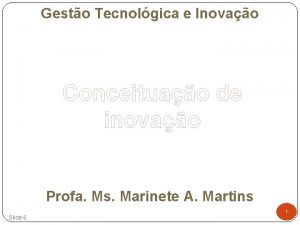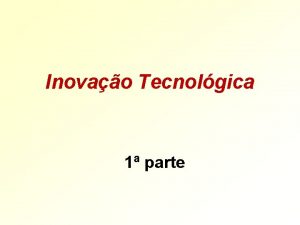SESSO 6 EMPRESAS MULTINACIONAIS SISTEMAS NACIONAIS DE INOVAO











































































- Slides: 75

SESSÃO 6 EMPRESAS MULTINACIONAIS, SISTEMAS NACIONAIS DE INOVAÇÃO E ESTRATÉGIAS TECNOLÓGICAS

TEORIAS DO INVESTIMENTO INTERNACIONAL

TEORIAS DO INVESTIMENTO INTERNACIONAL v Imperfeições do Mercado: Hymer-Kindleberger v Ciclo de Vida do Produto: R. Vernon v Reacção Oligopolística: F. Knickerbocker v Teoria Japonesa: K. Kojima v Internalização: P. Buckley & M. Casson v Paradigma Ecléctico: J. Dunning v Perspectiva Evolucionista: J. Cantwell; B. Kogut & U. Zander

CICLO DE VIDA (Vermon) Hipóteses de Base 1) Alteração temporal das condições de produção e comercialização dos produtos 2) Conhecimento tecnológico limitado fora das fronteiras nacionais 3) Existência de economias de escala 4) Os gostos variam com o rendimento e os produtos podem ser estandardizados e vários níveis de rendimento 3 fases no ciclo 1) Produto Novo 2) Produto em Desenvolvimento 3) Produto Estandardizado

TEORIA DA INTERNALIZAÇÃO (Buckley & Casson) Vantagens – Controle e planeamento da produção e comercialização – Exploração do poder de mercado pela prática de preços discriminatórios – Evitar situações de monopólio bilateral – Evitar os problemas da transferência de conhecimentos – Evitar a intervenção governamental A Informação como bem Intermédio

PARADIGMA ECLÉCTICO (J. Dunning) Paradigma O. L. I. Ownership Location Internalisation 3 Condições para Investir no Exterior 1. A empresa dispões de Vantagens Específicas 2. É preferível explorar tais vantagems por si própria que transmiti-las a outros (Internalização) 3. A exploração é mais vantajosa fora do país de origem. O país de destino deverá ter Vantagens de Localização

EVOLUÇÃO DA CONCEPTUALIZAÇÃO DA EMPRESA MULTINACIONAL

EVOLUÇÃO DA CONCEPTUALIZAÇÃO DA EMPRESA MULTINACIONAL (EMN) • Perspectiva Tradicional: A Empresa Hierárquica • Perspectiva Actual: A EMN como Rede de Unidades Dispersas Geograficamente

A CONTRIBUIÇÃO DE BARTLETT & GHOSHAL v Imperativos de Gestão v. Flexibilidade/Adaptação Local v. Eficiência v. Aprendizagem à Escala Mundial v Tipos de Organização v. Multinacional v. Internacional v. Global A Transnacional como Solução

MODELO DE ORGANIZAÇÃO MULTINACIONAL FEDERAÇÃO DESCENTRALIZADA Mentalidade Multinacional Operações no estrangeiro como uma carteira de negócios independentes Relações Sede Filiais Muito Activos, Responsabilidade s e decisões chave descentralizadas Controlo pessoal, informal complementado com controlos financeiros Fonte: Bartlett & Ghoshal (1991) simples

MODELO DE ORGANIZAÇÃO INTERNACIONAL FEDERAÇÃO COORDENADA Mentalidade Internacional Operações mo estrangeiro como apêndices de uma actividade central no país de origem Controlo Sistemas formais de planeamento e controlo Há activos, recursos, responsabilidades e decisões descentralizadas, mas controlados pela sede Fonte: Bartlett & Ghoshal (1991)

MODELO DE ORGANIZAÇÃO GLOBAL “CENTRO DA RODA” Mentalidade Global Controlo Operacional Operações no estrangeiro encaradas como canais de distribuição para um mercado global unificado Forte controlo central das decisões, recursos e informação A maioria dos activos, recursos responsabilidades e decisões estratégicas está centralizada Fonte: Bartlett & Ghoshal (1991)

HOW FIRMS ENVISAGE INTERNATIONAL BUSINESS: MANAGEMENTALITIES v International • Domestic market as the core • Foreign Businesses (and affiliates) as appendages v Multinational • Awareness of differences between domestic and international environments • Adaptation to local requirements: responsive marketing v Global • The World as the unit of analysis • Product standardization promotting /exploiting similar “ways of life” • “The same thing, the same way, everywhere”


A “Rede Integrada” Recursos e Significativos fluxos de capacidades componentes, produtos, distribuídas e recursos, pessoas e especializadas informação entre unidades interdependentes Processo complexo de coordenação num ambiente de decisão partilhada Fonte: Bartlett & Ghoshal (1991)

TRANSNATIONAL PROCESSES 1. From Symmetry to Differentiation: Integrating and Exploiting capabilities, knowledge bases and linkages 2. From Dependence or Independence to Interdependence: Dispersed and specialized configuration of resources: the integrated network Inter-unit integration mechanisms to promote synergies Movement of personnel as a tool for promoting inter-dependence 3. From Unidimentional Control to Differentiated Coordination: Reccourse to different mechanisms to coordinate flows of goods, resources and information 4. Linking National Competences to achieve Worldwide Learning and Competitiveness

A GESTÃO DA INOVAÇÃO À ESCALA MUNDIAL: NOVAS DIN MICAS

THE CORE QUESTIONS 1. Fostering Intra-Firm Cross. Border communication of specific knowledge 2. Promoting external communication to absorb other’s knowledge while preventing the “leakage” of firm’s specific knowledge 3. How to avoid knowledge accumulation paths leading to “Deadlocks”

THE MNE AS A REPOSITORY OF KNOWLEDGE 1) Existence of Specific Advantages (knowledge or knowledge-based rights) 2) International Exploitation (across borders, within firm’s boundaries)

R&D EXPENDITURES OF FOREIGN AFFILIATES AS A % OF TOTAL R&D EXPENDITURES Fonte: R. Narula (2005), The Globalisation of Innovation, http: //www. unctad. org/sections/meetings/docs/narula_en. pdf

Main forms of internationalisation of industrial R&D Establishment of R&D activities in the host country by foreign-controlled affiliates (inward investment) Setting up R&D laboratories abroad by investing countries (outward investment) Creation of joint ventures Co-operation agreements or technological alliances International R&D subcontrating Fonte: Thomas Hatzichronoglou (2006), Recent Trends in the internationalisationof R&D in the enterprise sectot, OCDE

Trends of R&D activities by multinationals Fonte: Thomas Hatzichronoglou (2006), Recent Trends in the internationalisationof R&D in the enterprise sectot, OCDE

Fonte: Thomas Hatzichronoglou (2006), Recent Trends in the internationalisationof R&D in the enterprise sectot, OCDE

Fonte: Thomas Hatzichronoglou (2006), Recent Trends in the internationalisationof R&D in the enterprise sectot, OCDE

Fonte: Thomas Hatzichronoglou (2006), Recent Trends in the internationalisationof R&D in the enterprise sectot, OCDE

Fonte: Thomas Hatzichronoglou (2006), Recent Trends in the internationalisationof R&D in the enterprise sectot, OCDE

Fonte: UNCTAD, WIR (2005)

Fonte: UNCTAD, WIR (2005)

Fonte: UNCTAD, WIR (2005)

Fonte: UNCTAD, WIR (2005)

Fonte: UNCTAD, WIR (2005)

AS EMN E OS SNI

EMPRESAS MULTINACIONAIS E SISTEMAS NACIONAIS DE INOVAÇÃO v Uma inter-relação cada vez mais intensa v A concorrência internacional para atracção IDE intensivo em conhecimento. . . mas grande selectividade nas escolhas v A actividade de I&D como algo de adquirido e não como dado (mas há excepções) v A crescente importância do cruzamento de saberes e de bases de conhecimento (conjugando global e local)

EMPRESAS MULTINACIONAIS E SNI EM PAÍSES MENOS AVANÇADOS v Qual o papel desempenhado pelas filiais de EMN? ‘Abafando’ a dinâmica inovadora local? (por aquisições, p. exº. ) ou Filiais como tutoras e mobilizadoras de redes? v A internacionalização das ligações locais: papel das filiais na internacionalização das empresas nacionais v Relacionamento e exigência de novos patamares

EMPRESAS MULTINACIONAIS E SISTEMA DE INOVAÇÃO EM PORTUGAL: DOIS EXEMPLOS

MNE CENTRES OF EXCELLENCE AND ACQUISITIONS: LONG EVOLUTIONARY PATHS OR CAPTURING OPPORTUNITIES? Vitor Corado Simões Pedro Nevado 2001

SUBSIDIARY DEVELOPMENT PROCESSES AND GAINING Co. E MANDATES • EVOLUTIONARY, TIMECONSUMING PROCESS (FORSGREN, JOHANSON AND SHARMA, 2000) • DOES IT STILL HOLD FOR ACQUISITIONS? (FRATOCCHI AND LORENZONI, 2000)

DEFINITION OF Co. E A Co. E is “an area of expertise for which the subsidiary is recognized by the corporation, and which other parts of the corporation draw on” (Birkinshaw, 1998: 291) 3 MAIN FEATURES v Competences v Use of such competences by other units v Recognition

Earned Co. E Mandate “Tapped” Given

AUTONOMY VERSUS INTEGRATION • Autonomy is Needed for the Subsidiary to Create, Develop and Strengthen its Capabilities • Integration is Needed to have Influence over other Units of the MNE Network “Too much autonomy makes the subsidiary mandate potentially vulnerable to divestment (as a spin-off company) or decline (because of a lack of corporate investment)” (Birkinshaw, 1996: 488) • How to Balance Knowledge Development with Knowledge Sharing?

THE ROLE OF ACQUISITIONS • Is an historical process of competence development and interrelationships with other MNE units needed? (“Acquired Subsidiaries cannot become Co. Es Overnight”, Fratocchi & Holm, 1998) • Or can Co. E rapidly stem from acquisitions (picking up potential “leaders)?

3 CASE STUDIES 1 ABB PORTUGAL 2 ALCATEL PORTUGAL 3 VULCANO (R. Bosch Group)

1 • ABB PORTUGAL 1990: SENETE JOINT VENTURE BETWEEN ABB (40%), MAGUE AND IPE (SOREFAME)) SOREFAME HISTORY: – CREATED IN 1943 – HYDROELECTRICAL POWER INVESTMENTS – POWER AGREEMENT: SPECIALIZATION • 1992: HIDRO-SOREFAME SOLE PRODUCER OF HYDROMECHANIC EQUIPMENT WITHIN ABB • 1994: ABB CONTROLS 70% OF SENETE • 1995: HIDRO-SOREFAME CHANGED INTO ABB HIDRO • 1997: FULL CONTROL OF SENETE BY ABB HIDRO BECOMES”LEAD CENTRE” • 1999: POWER BUSINESS INCLUDED IN A JV WITH FRENCH PARTNER • 2000: EQUITY STAKE SOLD TO FRENCH PARTNER (THE PORTUGUESE COMPANY STILL A Co. E)

ALCATEL PORTUGAL 2 • 1987: DEAL ALCATEL/ITT ON TELECOMUNICATIONS EQUIPMENT PORTUGUESE SUBSIDIARY “INHERITED” • 1988: PORTUGUESE SUBSIDIARY ACTIVITY CHANGED FROM SEMICONDUCTORS AND CONSUMER GOODS TO TELECOMMUNICATIONS EQUIPMENT • 1989: LOCAL SOFTWARE CENTRE ESTABLISHED • 2000: 5 Co. Es IN ALCATEL PORTUGAL – – – – COILS AND TRANSFORMERS CALL CENTRES (FOR SOUTHERN EUROPE) NETWORK MANAGEMENT COMMUNICATIONS FOR RAILWAY APPLICATIONS GSM NETWORKS PLANNING AND OPTIMIZATION

“NETWORK MANAGEMENT COMPETENCE CENTRE” Ø Original Opportunity (1991): Services for Portuguese GSM Operator – Capability Development – Reference Ø MNE Network Involvement: Participation in Development of Products for France Telecom and Deutche Telekom Ø Capability Demonstration (1996): Development of a New Traffic Management System for the Whole Ggroup Ø Co. E Recognition (1997): Network Management Competence Centre

3 VULCANO • Born as a Licensee OF Robert Bosch Gmbh (1977) • Own Brand Lauching – Vulcano (1983) • 50% of Portuguese Market; 8 TH Largest European Water Boller Manufacturer (1988) • Licensing Agreements about to Eexprire: Options A) Stand alone B) Renew C) Strengthen Relationship • Majority Equity share Acquired by R. Bosch • Market Leader in Europe (1992) • Group Competence Centre in Water Boller • Internationalization Drive – Licensing: Morocco, Tunisia, Egypt and Brazil – Direct Investments: China, Chile and Australia

ACQUISITIONS 1 2 PRE-EXISTING LINKS 2 YEARS 3 PRE-EXISTING LINKS 10 YEARS 4 YEARS CENTRE OF EXCELLENCE THINGS TAKE TIME… …BUT NOT TOO MUCH!

IMPORTANCE OF LOCAL ENVIRONMENT 1 2 3 Market opportunities Market performance Government Policy Technology/ Knowledge Linkages

CONCLUSIONS 1) ACQUISITION DRIVEN Co. Es ARE DIFFERENT 2) HEADQUARTERS RECOGNITION (AND “PICKING UP”) IS OFTEN FASTER THAN PEER RECOGNITION 3) LOCAL ENVIRONMENT RELATIONSHIPS MATTER 4) TO LEVERAGE THOSE RELATIONSHIPS AT GROUP LEVEL, STRATEGIC INTENT AND MANAGERIAL INITIATIVE ARE RELEVANT INGREDIENTS

NETWORKS AND LEARNING PROCESSES: A CASE STUDY ON THE AUTOMOTIVE INDUSTRY IN PORTUGAL Vitor Corado Simões 2002

THE AUTOMOTIVE INDUSTRY v Globalisation v Complexity and Changing Relationship Patterns v Strategic Alliances

FDI IN THE PORTUGUESE AUTOMOTIVE INDUSTRY: AN HISTORICAL RETROSPECT 1963: “Assemblying Law” 1972: Revision of the Assemblying Régime 1979: “Framework Law” on the Automotive Sector RENAULT PROJECT (1980) 1986: EC Accession AUTO-EUROPA PROJECT (1991) [FORD + VOLKSWAGEN]

CONCEPTUAL FRAMEWORK v The automotive supply chain as a network v Business Networks Approach: The Framwork of Haakansson (1987) [Actors– Resources– Actibities] v The “Flagship Firm”: The five partners Framework of Rugman & D’Cruz (2000) v The five dimensions of Inter. Organizational Networks (Ebbers, 1997) [Resource Flows, Information Flows, Assignment of Property Rights, Coordination Mechanisms and Mutual Expectations

METHOD v. Working out the Sytructure of Focal Networks v. Selection of Companies v. Undertaking of Case Studies v. Comparative Inter-Case Analysis


RENAULT NEWORK


THE RENAULT NETWORK v Local value added commitments Support to domestic suppliers’ development v Suppor = Provision of Technical Assistence + Training + Tolerance (Prices, Quality) v EC Integration Strategic Change v Dismantling the Renault Complex v Lasting effects: Stimulating of learning processes, Credibility. T Understanding how the industry works, and Sstrong relationships with a few suppliers

THE AUTO-EUROPA NETWORK v Cooperative Spirit v Autonomy Constraints: Different Relationships Modes v Learning with Auto-Europa: 1) Transformation Activities Quality Requirements and Support Help in Problem Solving Personal Exchange and Inter-action Engineering Dialogue 2) Transactional Activities Immersion in a Lean Product Environment Understanding Auto-makers’ Requirements Setting up of Relationships and Trus-Building Processes with Ford and VW v Requirement to Succeed Creating Proximity Consistent Performance “Good Surprises”


COMPARING THE TWO NETWORKS Time + Context Differences Evolution Relationships Model Reduced Subsidiary Autonomy Increased Performance Requir’ts Similarities Networks led by a Subsidiary FDI Attraction Support (with some limitations) to local Suppliers Consequence: Learning Instruments HOW DEEP WAS LEARNING?






FDI, NETWORKS AND LEARNING 1. The relevance of learning about transcational activities: “We learned the way how VW works” 2. The creation of relational grounds: Internationally Replicable? 3. The importance of mutual expectations: “The motivation for exceeding customer’s expectations” 4. Forbearance attitudes and past performance 5. Escaping from a dyadic logic and from a purely conflitual perspective: playing the “collaborative manufacturing” game 6. Learning and networking positioning as a never-ending process: • • Blending exploiting and exploring Up-grading internal competencies and relational capital

PROCESSOS DE INOVAÇÃO TRANSNACIONAL

INNOVATION PROCESS CENTRAL LOCALLY LEVERAGED GLOBALLY LINKED Fonte: Adaptado de Bartlett & Ghoshall (1989)

INOVAÇÃO CENTRAL Vantagens – Controlo da Tecnologia (Garantias de Apropriabilidade) – Relacionamento Inter-Departamental (Inter-acção, desenvolvimento, Produção, comercialização) – Rapidez de Desenvolvimento e Lançamento de Novos Produtos Riscos – Conflitos Casa Mãe / Subsidiária – Insensibilidade às Necessidades Diversificadas dos Mercados

INOVAÇÃO LOCAL Vantagens – Adaptação às Condições Locais – Aproveitamento e Estímulo das Competências das Filiais Riscos – Duplicação de Esforços (Multiplicidade de “Reinvenções da Roda”)

LOCALLY LEVERAGED Vantagens – Estímulo da Criatividade das Filiais em Proveito de Toda a Empresa Riscos – Dificuldade de Transferência devida às Especificidades Nacionais – Reacções Negativas devidas ao Síndroma NIH

GLOBALLY LINKED Vantagens – Estimular e Aproveitar de forma Integrada as Capacidades das Filiais – Obter Economias de Gama à escala Mundial – Resposta Comum a Estímulos (eventualmente) Localizados – Potenciar Aprendizagem à escala Mundial Riscos – Elevados Custos de Coordenação – Ambiguidade, Falta de Integração e Excessiva Difusão da Autoridade

NOVOS MODOS DE ORGANIZAÇÃO • Mandatos Globais • Plataformas de Produção • Centros de Excelência

PAPEL DOS CENTROS DE EXCELÊNCIA • DESENVOLVIMENTO CONHECIMENTOS • INTEGRAÇÃO DE CONHECIMENTOS • INSERÇÃO NA REDE
 Empresas multinacionais exemplos
Empresas multinacionais exemplos Inovao
Inovao Sesso a 90
Sesso a 90 Sesso cinema
Sesso cinema Vampate notturne
Vampate notturne Calorie orgasmo
Calorie orgasmo Ato de supremacia de henrique viii
Ato de supremacia de henrique viii Parametros curriculares nacionais lingua portuguesa
Parametros curriculares nacionais lingua portuguesa Sistema de contas nacionais
Sistema de contas nacionais Missoes nacionais
Missoes nacionais Faces moedas euro
Faces moedas euro Ejemplo de ventaja competitiva
Ejemplo de ventaja competitiva Demografia das empresas e estatísticas de empreendedorismo
Demografia das empresas e estatísticas de empreendedorismo Empresas transnacionais
Empresas transnacionais Administracin de empresas
Administracin de empresas Empresa familiar definicion
Empresa familiar definicion Registro de ascensores
Registro de ascensores Iso 26000 empresas certificadas
Iso 26000 empresas certificadas Matriz peyea ejemplos reales de empresas
Matriz peyea ejemplos reales de empresas Prevenimss empresas
Prevenimss empresas Umsa administracion de empresas
Umsa administracion de empresas Ganadores del premio deming
Ganadores del premio deming Cmm cmmi
Cmm cmmi Empresa publica mexico
Empresa publica mexico Empresas estatales chile
Empresas estatales chile As empresas são grandes coleções de processos
As empresas são grandes coleções de processos Matilde machado
Matilde machado Clasificacin de las empresas
Clasificacin de las empresas Tipos de empresas según su actividad
Tipos de empresas según su actividad Como se calcula el crédito especial empresas constructoras
Como se calcula el crédito especial empresas constructoras Entidades sin fines de lucro en paraguay
Entidades sin fines de lucro en paraguay Modelos de oligopolio
Modelos de oligopolio Acercate empresas
Acercate empresas Administracin de empresas
Administracin de empresas Integracion vertical y horizontal
Integracion vertical y horizontal Ventajas y desventajas de las tics en el turismo
Ventajas y desventajas de las tics en el turismo Empresas de entretenimiento en argentina
Empresas de entretenimiento en argentina Coinversiones ventajas y desventajas
Coinversiones ventajas y desventajas Estatísticas do cadastro central de empresas
Estatísticas do cadastro central de empresas Empresas
Empresas Robert katz habilidades gerenciales
Robert katz habilidades gerenciales Oligopsônio
Oligopsônio Charlas coaching empresas
Charlas coaching empresas Entel conviene empresas
Entel conviene empresas Empresas geocentricas
Empresas geocentricas Ganadores premio deming
Ganadores premio deming Downsizing concepto
Downsizing concepto Ventajas competitivas ejemplos de empresas
Ventajas competitivas ejemplos de empresas Plyca empresas
Plyca empresas Layout
Layout Entelconviene
Entelconviene Caracteristicas de un comerciante individual
Caracteristicas de un comerciante individual Clasificacin de las empresas
Clasificacin de las empresas Clasificaciones de los sistemas operativos
Clasificaciones de los sistemas operativos Tfg ingeniería de sistemas aeroespaciales
Tfg ingeniería de sistemas aeroespaciales Sistemas
Sistemas Liquidos imiscíveis
Liquidos imiscíveis Pensamiento aleatorio ejercicios
Pensamiento aleatorio ejercicios Los sistemas en equilibrio tienen propiedades mensurables.
Los sistemas en equilibrio tienen propiedades mensurables. Que es un sistema social
Que es un sistema social Hebras sistemas operativos
Hebras sistemas operativos Modelado
Modelado Sistemas uni
Sistemas uni Sistemas operativos
Sistemas operativos Banco de dados e sistemas de informações de rh
Banco de dados e sistemas de informações de rh Sistemas digestivos en animales
Sistemas digestivos en animales Sistemas equivalentes de fuerzas
Sistemas equivalentes de fuerzas Caracteristicas de los sistemas embebidos
Caracteristicas de los sistemas embebidos Ejemplos de ecuaciones lineales en una empresa
Ejemplos de ecuaciones lineales en una empresa Sistema 2
Sistema 2 Sistemas mecanicos 6to año
Sistemas mecanicos 6to año Arquitecturas de sistemas distribuidos
Arquitecturas de sistemas distribuidos Unidad 4 sistemas de ecuaciones diferenciales lineales
Unidad 4 sistemas de ecuaciones diferenciales lineales Sistema de referencia inercial
Sistema de referencia inercial Totalitarismo ppt
Totalitarismo ppt Sistemas de crianza de cuyes
Sistemas de crianza de cuyes
